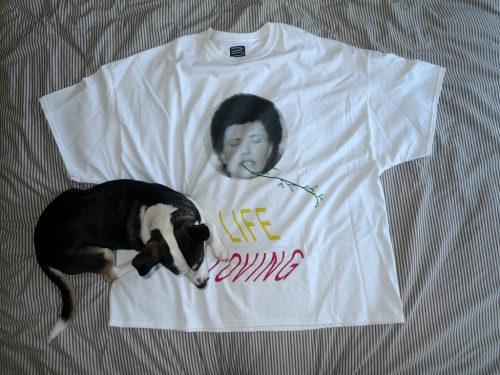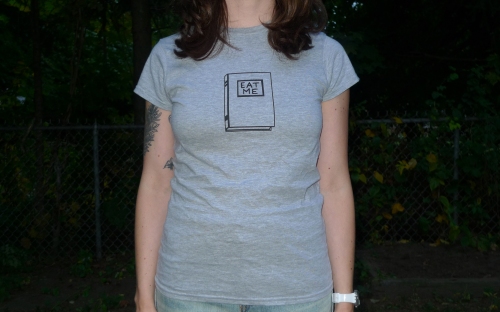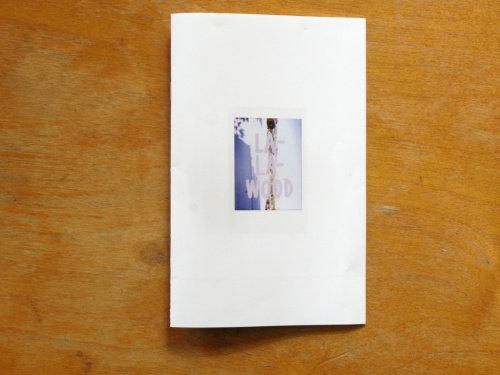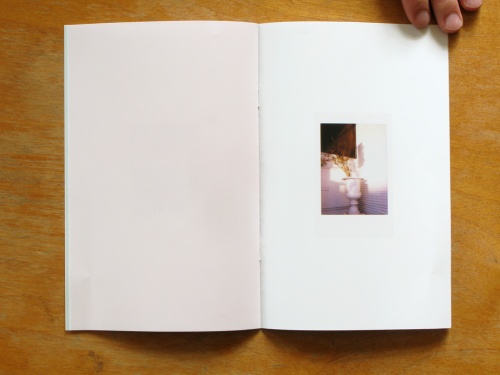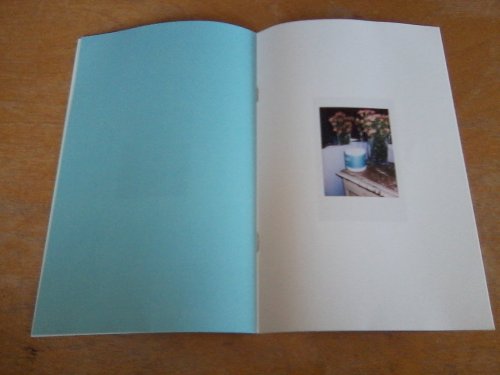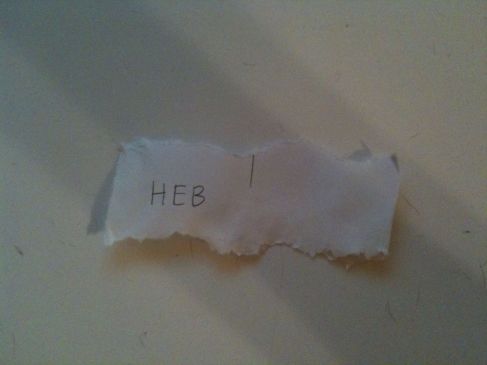T SHIRTS OF 2014
I realized recently that I acquired a LOT of t-shirts this year. Tee shirts. T shirts. OK. I was so busy getting t shirts that I did not blog at all!
Here is blog post with the ART T SHIRTS that I got in 2014, in order (I think). My friend Randy, who works in the t shirt business, told me that Gildan makes the most t shirts and that seems accurate from these art shirts.
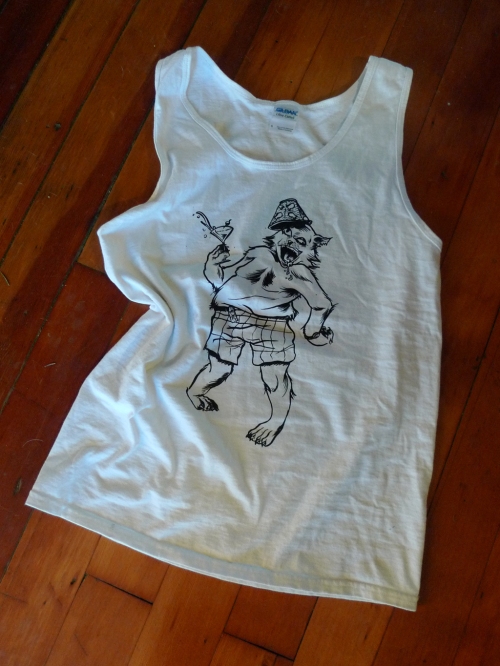 This is Party Kat tank top by Eric Benton, who is a wicked talented illustrator. The deal is that when you get one of these you put it on and don’t take it off until you are done partying so that it becomes filthy. I partied less in 2014 than in years past, so I failed Party Kat. You can buy one from him.
This is Party Kat tank top by Eric Benton, who is a wicked talented illustrator. The deal is that when you get one of these you put it on and don’t take it off until you are done partying so that it becomes filthy. I partied less in 2014 than in years past, so I failed Party Kat. You can buy one from him.
This is a very giant XXXXXXL t shirt (dog for scale, the dog is size small/medium). I love this shirt so much! I am pretty sure that’s Elizabeth Clare Prophet and the words say “LIFE LOVING”. My e-friend/pen pal Nate made this and then gave it to me.
This t shirt is one that I got at the New York Art Book Fair. It fits, which is weird. I bought it from the ladies of Three Words Press because Gee Vaucher designed it for them and Gee Vaucher is extremely cool and important. Also because I am a librarian it is funny to wear.
Here is a moody picture of shirt made by Olivia Kates, who is a student at RISD. This is the most metal shirt I bought, I think. The back says: Art Is Dead / Long Live / SPORTS. You can buy one for yourself here.
This is a shirt made by Esther S White. Her Anxietees project has included many editions of t shirts like this one and also unlike this one. Esther is a great person and our dogs are best friends.
Wow, what a crazy year it’s been. I hope that in 2015 that cops kill fewer people than they have in previous years since the beginning of time, and that I remember to use the terrible giant calendar I bought for myself. Stay safe and warm, and Happy New Year!
Filed under: art, lists | Leave a Comment
Tags: elizabeth clare prophet, t shirts
LALAWOOD
I wanted to make a little book of the instant photos I took in LA at the end of December, so I decided to do my first experiment with print-on-demand. Trevor has made some nice things with MagCloud, so I tried that. I think it came out nicely. :-)
Trevor has one, so there’s that.
I really like Mike Slack’s books, if you can’t tell.
If you would like to buy a copy, it’s $6. Purchase with Paypal here, or contact me directly to make other arrangements!
Filed under: art, photography, pictures | Leave a Comment
Tags: books, los angeles
Aaron Swartz
Aaron Swartz, Precocious Programmer and Internet Activist, Dies at 26
I didn’t know much about Aaron Swartz until seeing him as part of Rhizome’s Seven on Seven last year; he and Taryn Simon collaborated on a beautiful project, the Difference. He seemed lovely, and very smart, and talented. I am very sad.
Filed under: Uncategorized | Leave a Comment
Tags: aaron swartz, information
ORPHAN DOGS OF THE ART KIND
So before I went to New Hampshire, I challenged myself to make a super quick zine. It started with a beautiful phrase I came up with at work: Dogs in the Public Domain. I googled dogs in the public domain and found some beauties. I also cut some shapes out of paper, they are in crystal shapes. All together, it is called DOGS IN THE PUBLIC DOMAIN AND ALSO SOME CRYSTALS.
If you would like the zine, it is $2. I think I did a great job on it.
I would like to say that the public domain is a wonderful thing, because copyright is a tricky thing. I think it is important, but at its worst it mostly just provides an excuse for the litigious to cause suffering to the under-cautious. It makes people do foolish things, like sue moderately well-intentioned artists who in turn lie about their source material. There is a balance that is impossible to strike between protection and use, especially in the case of orphan works (hostage works), and I am therefore ambivalent about it. Reform is necessary, especially with the proliferation of images and other material over the internet.
While I was making DOGS, I realized something about appropriation art. For nearly 10 years, I have said that I hate Sherrie Levine and all she stands for. As I googled these dogs and then purposefully removed (most) traces of provenance, I realized that I AM SHERRIE LEVINE. Except with dogs instead of Walker Evans. I (like to) think we both were, in our own ways, writing love letters to the Public Domain. For a long time I thought Levine’s work degraded Evans’. First of all, that’s dumb. Second of all, it wasn’t so much that she was demonstrating anything about the quality or content of his images, or her awareness of them. It was that she could do what she did– –without recrimination, because Evans’ FSA photos are in the public domain, as government works, and you can write to the Library of Congress and get a print, and do whatever you want with it. They’re not prints that Evans would have approved, but they’re an official iteration of his work.
As I now am ok with Sherrie Levine, I am really markedly annoyed by this fucking article on Hyperallergic that’s been floating around, My Chuck Close Problem, by artist Scott Blake. I know I’m not the only one. And I wrote about it yesterday but today I’m redacting what I wrote because I just want this story to go away! Read Chuck Close’s “response,” which I find perfectly reasonable, here. It all brings up some issues about copyright and fair use, but Blake is handling it in a very strange way. I wonder what’s really going on there.
:-\
P.S.
:-)
Filed under: art, photography | Leave a Comment
Tags: copyright, copyright blog 2k12, zine
SPIRIT FURNITURE
When can I stop? Soon? I hear I get to do nothing in about 5 days. That will be cool.
~not complaining~
Here are some gross scans of a bunch of dumb stuff that I made then put in frames then put in the mail. I will be peddling these ridiculous wares at BROKE on June 9 in Peterborough, New Hampshire. It’s going to be a magical, wonderful weekend, for a trillion reasons!
∆ ∆ ∆
There are things I could say about these guys, but who cares? Really, I’ll tell you anything you want to know. For example, I’m listening to Rammstein right now.
I will also be selling prints, watercolor paintings I made about the internet, and a zine with dogs in it.
XOXO!
Filed under: art | 3 Comments
Tags: broke, collage
PAINTER OF LIGHT
I have said some pretty terrible things about Thomas Kinkade in my time. I have been saying things about him for years. And although my gut reaction to his death was snarky as hell, I think his “oeuvre” raises a lot of important questions that are asked over and over again concerning ART in this country. I have been thinking critically about TK since a show at Middlebury College in 2009, Making Sense of Thomas Kinkade.
I think striving towards making something purely aesthetically, subjectively beautiful is fine. For example, my favorite radio station in Austin is Simply Beautiful 91.3. “Putting a smile on your face!” They play elevator music, essentially. Instrumental versions of songs like “I’m Not In Love.” There is no irony in my appreciation for this radio station. I get kinda heated when I drive, so to have this sort of cake playing in the car is good for everyone. I also love Disneyland mostly for its prettiness. So Thomas Kinkade, in his self promotion and self defense, said things like this:
I view art as an inspirational tool. People who put my paintings on their walls are putting their values on their walls: faith, family, home, a simpler way of living, the beauty of nature, quiet, tranquillity, peace, joy, hope. They beckon you into this world that provides an alternative to your nightly news broadcast. The New York Times, 2001.
or
People are reminded that it’s not all ugliness in the world. The New York Times
That is FINE. Aesthetics, pure aesthetics, are important to some people; I understand that part of that is that they don’t want to have to think about anything when they look at “art.” I am saying this objectively, no value judgment. Morley Safer, for example, demonstrates that he does not want to be challenged, visually or intellectually, by contemporary art. Sometimes I don’t want to think about art either. Again, something purely lovely is nothing to scoff at.
This is what seems to be the predominant state of things to me, and there is a tension here that both sides feed into (“both sides” meaning this silly dichotomy between appreciators of “high” and “low” art): Art that is ugly or strange or conceptual, that makes one uncomfortable, is for the elite; art that is pretty, uncomplicated, intended to inspire good feelings, is for everyone else- regular folks.
This is a useless distinction to make, in my opinion. At the same time, just because I am in graduate school and am paying to talk about things like this with other people in graduate school does not make my opinion more valid. But we have been talking about this, we “elite” 20-somethings, and we are SAD about it. Because anyone is allowed to look at anything; anyone is allowed to feel whatever they choose when they look at something; anyone is allowed to have thoughts about things they look at. It is so purely democratic and wonderful. If someone looks at a painting, and they say, “I don’t get it,” I think that is SO GREAT. Ok, run with that. Why don’t you like it? What do you think is going on here, really? Gut reaction is great, but you are allowed to think about this a little bit.
Before I get all dark, I will quote Dave Hickey:
The justification for this pretense to disengagement derives from our Victorian habit of marginalizing the experience of art, of treating it as if it were somehow “special”–and, lately, as if it were somehow curable. This is a preposterous assumption to make in a culture that is irrevocably saturated with pictures and music, in which every elevator serves as a combination picture gallery and concert hall.
OK?
The New York Times obituary includes this paragraph:
In the 1980s, Mr. Kinkade said, he became a born-again Christian. The change dovetailed with a shift in his career path. Rebelling against what he considered the elitism of modern art, Mr. Kinkade moved his focus to retail, not a traditional gallery system. He began publishing inexpensive prints of his work and, later, opened his own galleries.
This part about “rebelling against what he considered the elitism of modern art” is what I find troubling. Rather than picking on a dead man, I will deal with this characterization, as its own concept.
First off, a lot of artists are not making any money at ALL. So maybe calling Kinkade’s work “art” is just moot, because many artists make work because they can’t not, even though their work is unmarketable. Maybe I am actually just doing exactly what I am saying NOT to do? Well, I’ve recognized that possibility, so let’s keep going.
Another thing we have talked about in class is the problem of approaching something you care about in this framework of hoping to legitimize it. Making work that is pointedly antithetical to someone else, rather than just making the work you want to make (be it paintings, writing, music, politics), means recognizing one’s own marginal status, and affirming the status quo. If you believe something is important, think about the reasons why you think it is important, and maybe talk about that instead. So you find the art market at large horrifying; then great, make your “affordable,” accessible work. Don’t say, my art is for everyone, unlike that garbage over there. And don’t tell me that you are just a regular guy who just likes pretty pictures, or who just likes what folks like (Nascar, Disneyland) while you make millions of dollars, and sell tract housing at $450,000 a pop in a fucking suburban UTOPIA with your name on it.
So this turned into an empire, an empire possibly based on filling a need for comforting pictures, possibly based on reactions against modern art. And some people became ADDICTED to buying Thomas Kinkade works. This was addressed in 60 Minutes segment on TK in the 1990s, which I can’t find online, mostly because he just died and it is therefore ungoogleable. (HAHA 60 MINUTES AND ART. No really, it’s great.)
My point? The point is that I think it’s a big problem to say “I do not feel included in your museum or in your concept of art” and to have that be your platform. Stop, and maybe take that feeling and say, ok, why? What would make me feel better? Maybe step outside of yourself and look at the unfamiliar. Maybe it’s a luxury to be able to do that. I mean, I am a young white woman with a degree in Art History, I grew up on a farm, that’s where I am coming from. I guess what I’m saying is understand what you believe in, and work from there. I am thinking, step out of the shadow of what you don’t like or don’t understand, what you don’t want to understand. We are all just people, right? This us and them thing in art, it’s bullshit. Let’s all just calm down and look at things. Some of us want to just look; some of us want to look, then think way too much. It’s all valid. Let’s talk to each other.
ETA:
Ok Annie, follow this to its logical conclusion, then, because this is a two-way street: what is really going on in these TK paintings? Is it nothing, like he claimed? I would say NO. There is a lot about society and American going on. Also, maybe framing work in this way–it’s just meant to be beautiful and comforting, and an antidote to what you normally see–is a way of obfuscating what is really going on.
\\\ \\ \ \ \ \ \ \ \ \ \\ \ \ \ \ \ \ \ \ \ \ \ \ \ \ \ \ \ \ \ \ \\\ \ \ \ \\ \ \ \ \ \ \\ \ \ \ \ \ \ \\ \ \ \ \
APPENDIX:
HITLER STUDIES: TAKE IT OR LEAVE IT
/// / / / / / / / / / / / / / / / / / / / / / / / / / / / / / / / // / / / / / / / / / / / // / // / / / / / / // /
So.
Maybe it’s a huge mistake to do so, but I can take this further, and maybe I will be crossing a line here. I made a comment in public that was way too blithe and I want to explain why I thought even for one second that it was ok to do that. I will try to do this carefully. I will preface this by saying that I am NOT making a direct comparison between what Thomas Kinkade’s enterprise represents and a monster; I am giving one EXTREME example of the perils of one guy fucking with culture, and how that turns into exploiting people. Let me talk about history. This is history, ok? Nothing more. This all happened.
|| | | | | | | | | | | | | | | | | | | | | | | | | | | | | | | | | | | | | | | | | | | || | | | | | | | | | | || | | | | | | | |
Something I know a lot about is Nazis and art. A good portion of what I know I learned from this book, the catalogue for a show that was at LACMA, “Degenerate Art”: The Fate of the Avante Garde. If I am grossing you out, maybe look at that, or watch The Rape of Europa or something. Sometimes, when people bring up Nazis in an argument, you can just say, oh god, throw this whole thing out. But I am going to talk about CULTURE and HOW that Hitler guy was able to get people to agree with him. Before Hitler, culture in Germany was progressive. The Weimar Republic, ok? Bauhaus. The first museum to buy a Cezanne was in Germany. Basically all of my favorite painters were Germans in the early 20th century. With an economic downturn, and a shift in power, however, folks needed someone to blame. So. Hitler, and others. Hitler was a mediocre painter who did not get into art school. People love to talk about that. But what that means, is that he valued culture. He thought about art, in whatever way. He felt marginalized by the high art world. So, and he created the Ministry of culture to help carry this out, he talked about the irresponsibility of the government in paying so much money to put works of art in German museums. These works were maybe challenging, maybe not accessible to the casual viewer? Oskar Kokoschka, Otto Dix, Max Beckmann, Franz Marc, Wassily Kandinsky, Ernst Ludwig Kirchner. Artists from outside of Germany as well. How could this happen when Germany’s people were hungry and poor? When Germany was so wounded by World War II? Without taking into account that many German artists fought in WWI. Even though they were hungry and poor also, these artists became the enemy. These artists who cared maybe more than anyone about beauty, they were called insane and unpatriotic, and elitist, and therefore Jewish, because their art was so far beyond the pale. I want to cry right now, but this is important, ok? So, people got angry. The Folks, they got angry. They were already angry! But now, they agreed, this isn’t our culture. These guys, they’re not German. Even though they were not Jews, they had fought in the war, some of the artists were already dead, they had died in battle, fighting for Germany. The artists were forbidden from making work. The Bauhaus was shut down. Artists fled the country; some stayed and made work in secret; some of these artists even supported the National Socialist state, even they were in big trouble. Artists were sent to camps. New art was called for. They held a contest to fill a new museum, and the winners of the contest were ok painters who painted very unusual neo-classical themes, mostly featuring naked (naked, not nude) young women. The other art, the stuff I like, was pulled from the museums and hung across the way in Munich. The Degenerate Art exhibit of 1937 travelled around the country and was the best attended museum exhibit of all time. It was a mess. People ate it up. People saw a lot of paintings. And everyone was still poor. I think you know what happened next. I’ll stop here.
|| | | | | | | | | | | | | | | | | | | | | | | | | | | | | | | | | | | | | | | | | | | || | | | | | | | | | | || | | | | | | | |
Filed under: art | 3 Comments
Tags: am I an asshole?, critical thinking, Degenerate Art, Thomas Kinkade
TRUFFLE HOUND
As an alternative to my half baked huh what rants, here’s a pretty good post from BOOKFORUM about MoMA, Twitter, Celebrity Truffle Hounds, and MoMA chief curator Klaus Biesenbach: Klaus Werk
As AFC (xo) says: “Choire Sicha thinks Biesenbach’s tweets underscore the direction MoMA is heading in, and I’m not sure I like it. Can I say that and still give the Kraftwerk exhibition a thumbs-up?”
Yes you can, PJ! :-)
In other news I think my new artistic direction can be called “It Ain’t That Serious.” It’s about time. Here, a work in progress, taken by my PHONE. Because I’m BUSY but still want to paint. Right? 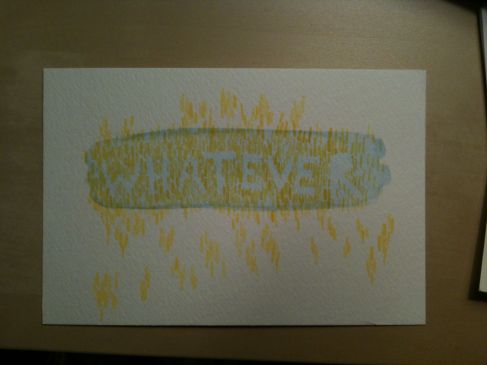
I mean this is just as good as this, right:
ETA: Morley Safer! It ain’t that serious! :-(((((( You make me sad! But Jerry Salz to the rescue!
Flacking for the piece on Friday, Safer told Charlie Rose and Gayle King, “Even Jerry Saltz says 85 percent of the art we see is bad,” adding that he’d suggest that it’s 95 percent. Whatever. I wanted to tell him that the percent I suggested doesn’t only apply to the present. Eighty-five percent of the art made in the Renaissance wasn’t that good either. It’s just that we never see it: What is on view in museums has already been filtered for us. Safer doesn’t get that the thrill of contemporary art is that we’re all doing this filtering together, all the time, in public, everywhere. Moreover, his 85 percent is different from my 85 percent, which is different from yours, and so on down the line until you get to Glenn Beck, who says everything is Communist. No one knows how current art will shake out. This scares some people.
Again: just look at a thing, ok?
Filed under: art, museum, the internet | Leave a Comment
bffs
Um, so, yeah
so did you know that
I have friends
Well I don’t know if that girl is my friend but whatever
Filed under: pictures, THE REAL WORLD | Leave a Comment
BROKE
I guess I should start planning for the one art thing I ever do: BROKE at The Thing in the Spring! The Thing is a magical weekend in Peterborough, New Hampshire, where I spent my formative years. Buddies, funtimes, and apparently there are going to be some MIND BLOWING SHOWS. Did I take any pictures of it last year? No? My pals have been putting this on for…I don’t know, 5 or 6 years or something? Really? The first Broke I did was in 2009.
Being in Peterborough is always kind of a mindfuck but I love the real live community there.
Filed under: art, events | Leave a Comment
Tags: magical weekend, mindfuck
